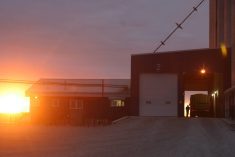HARRIS, Sask. – Craig Hanson returned to the family farm four years ago because he was frustrated working for other people “hitting their home runs.”
He was in Argentina working for the Prairie Agricultural Machinery Institute when his wife Karen Timoshuk, six months pregnant and with a toddler daughter, moved the household 200 kilometres west from Humboldt, Sask., to Harris, Sask.
Although both had been raised on farms, Timoshuk said going back into that life in June 1997 was scary.
Taking on the big debt would have been a tougher choice without their professional jobs. Hanson had worked for John Deere as well as PAMI since he got his engineering degree. He continues to do consulting work. Timoshuk works for the Canadian Co-operative Association, doing part-time work on international issues.
Read Also

VIDEO: Bittersweet harvest for this family farmhand
Bruce Burnett helps his brother harvest wheat and canola for the last time on the family farm in Manitoba where they both grew up.
“I grew up with ‘you buy it if you have cash,” she said. “There’s lots of financing here. I wouldn’t do the books. I wouldn’t sleep at night.”
Hanson bases his confidence in the future on a continuous cropping plan that includes a science-based five-year rotation of cereal-pulse-oilseed-cereal-pulse. Individual crops are finalized each year after studying the markets. Pulses improve the soil, which means less fertilizer is needed. As well, chemicals are carefully gauged with future crops in mind.
“I want this ground in shape so my kids can farm,” he said.
Organic production wasn’t possible, he added, because it requires tillage, which would lead to soil erosion in this dryland area.
“The cost of inputs is an issue, big time,” he said.
“Everyone’s making out great in agriculture except the farmers.”
The family grows crops on all 3,800 acres. There are no animals.
“We contemplated chickens for two minutes,” said Timoshuk, who grew up on a “complete animal farm” eating homemade butter and ice cream regularly. Hanson did not want cattle, leaving that to his two nearby cousins.
Their return was made easier by a succession plan that began a generation ago when his father and uncles farmed together. The extended family arrangement continues today with the cousins, but it has tightened up with the use of work contracts and monthly meetings, complete with agendas.
Hanson’s father became ill shortly after he came back to the farm. This sped up the transition.
“We ended up both shoulders in the traces a little earlier than we thought. To operate it, you need to own it. We made a 10-year agreement to buy the home quarter.”
Hanson’s mother, Francis, plays an important role on the farm. She said her husband’s illness and death were a wake-up call for everyone. They had incorporated in 1996 and upon his death, Francis became president of the company, with her son Craig as secretary-treasurer.
Francis, who lives in the nearby town of Harris, is also the farm’s bookkeeper.
“We own some voting shares, but Mom basically owns the farm,” Hanson said.
His four non-farming siblings are taken care of through life insurance to ensure they get something from the land.
Timoshuk does little farming, preferring the family management role and her half-time job. But she prepares meals at harvest.
“I fell into it just like my mother,” she said.
Francis said she inherited the meal job when her mother-in-law turned 50. But the family now has a new rule. If the men are within five kilometres of the house, they have to come in for their hot meal.
Life at Kinhop Farms Ltd., named for a former elevator point, is tranquil in late fall. But then community life revs up.
Hanson is the new president of the local crop production club and is active in the Lions club and the curling rink. This year he’ll have to beg off his usual role in dinner theatre. Timoshuk would like to volunteer more at the school, but her job requires some travel to organize meetings.
While Hanson and Timoshuk grew up on different types of farms, they agree on the similarity in values taught to them as children. They question whether being in a city can create the same love of nature.
Their two daughters are another reason for returning to the farm.
When Jasmine was in Grade 1, she asked Hanson if he was the second one to farm the land. When he recounted the family history, she concluded that “I could be the fifth one” to farm.
But first her parents want Jasmine and sister Julia to experience life away from the farm.
“I’d boot them out for five years, for them to put the farm into context,” Timoshuk said.
When Hanson was growing up, the farm was 1,200 acres and supported seven people. It also paid to put all the kids through post-secondary education.
“That is absolutely telling,” said Timoshuk of the changes in a generation.
The tradition of growing wheat and barley and hauling it to the local Saskatchewan Wheat Pool elevator has also changed. The farm now grows more oilseeds and pulses, which are trucked wherever the family can get the best price.
Ten years from now, Hanson figures he will still be farming the same way – “it’s sustainable, it’ll work. Hopefully it’ll be a bit more prosperous but the nuts and bolts will be the same.”
His wife said that if the farm was more prosperous, “I’d like to let go of some of what I’m doing and do more community work, maybe be a teacher’s aide.”
Then she adds that maybe they would package lentils and flax to sell at the farmer’s market.
“We’re only four years into this. We’ll look at ideas.”
















